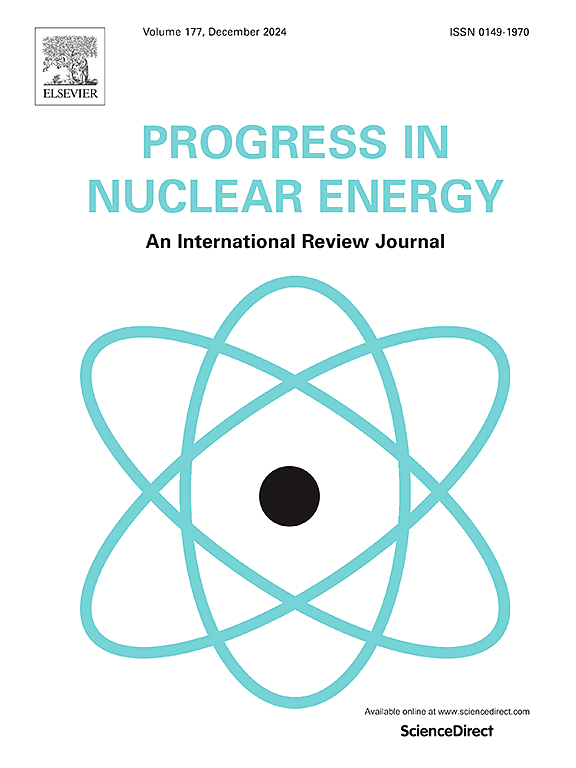Debris bed coolability in hypothetical core disruptive accidents: Theory, experiment, and numerical simulation review
IF 3.3
3区 工程技术
Q1 NUCLEAR SCIENCE & TECHNOLOGY
引用次数: 0
Abstract
The coolability of debris beds in severe accidents of sodium-cooled fast reactors (SFRs) is critical for preventing radionuclide release, yet existing research has predominantly focused on light water reactors (LWRs), leaving a systematic analysis for SFRs lacking. This paper reviews debris bed coolability through theoretical models, experimental studies, and numerical simulations, while contrasting the distinctions between LWRs and SFRs. Theoretical models reveal that the inclusion or exclusion of interfacial drag marks a key divergence—models like Reed's, which neglect interfacial resistance, are suitable for high-flow bottom-flooding, whereas formulations such as Schulenberg-Müller's better align with top-flooding scenarios. Experimental findings demonstrate that particle size distribution, geometry, and porosity significantly influence dryout heat flux (DHF). Multidimensional cooling strategies (e.g., bottom-flooding or downcomers) disrupt countercurrent flooding limits (CCFL), enhancing DHF by 1.5–2.7 × compared to conventional top-flooding. Numerical simulations confirm the predictive capability of codes like MEWA and MELCOR for homogeneous debris beds, yet limitations persist in addressing SFR-specific challenges, such as high-temperature liquid metal coolant behavior and complex flow regimes. Future work must prioritize SFR-focused experiments, extend models to liquid metal conditions, and strengthen experimental-simulation synergies to improve risk assessment reliability. This paper provides theoretical and technical foundations for optimizing SFR severe accident management strategies.
假设岩心破坏事故中岩屑床的冷却性:理论、实验和数值模拟综述
钠冷快堆(SFRs)严重事故中碎屑床的冷却性对防止放射性核素释放至关重要,但现有研究主要集中在轻水堆(LWRs)上,缺乏对SFRs的系统分析。本文通过理论模型、实验研究和数值模拟对碎屑床冷却性进行了综述,并对比了轻堆和堆芯堆的区别。理论模型表明,界面阻力的包含或排除标志着一个关键的分歧——像Reed的模型,忽略了界面阻力,适用于高流量的底部驱油,而像schulenberg - m ller的公式更适合于顶部驱油。实验结果表明,颗粒尺寸分布、几何形状和孔隙度对干热通量有显著影响。多维冷却策略(如底部驱油或降液器)破坏了逆流驱极限(CCFL),与传统的顶部驱油相比,DHF提高了1.5-2.7倍。数值模拟证实了MEWA和MELCOR等代码对均质碎屑床的预测能力,但在解决srr特定挑战(如高温液态金属冷却剂行为和复杂流动状态)方面仍然存在局限性。未来的工作必须优先考虑以sfr为重点的实验,将模型扩展到液态金属条件,并加强实验与模拟的协同作用,以提高风险评估的可靠性。本文为优化SFR严重事故管理策略提供了理论和技术依据。
本文章由计算机程序翻译,如有差异,请以英文原文为准。
求助全文
约1分钟内获得全文
求助全文
来源期刊

Progress in Nuclear Energy
工程技术-核科学技术
CiteScore
5.30
自引率
14.80%
发文量
331
审稿时长
3.5 months
期刊介绍:
Progress in Nuclear Energy is an international review journal covering all aspects of nuclear science and engineering. In keeping with the maturity of nuclear power, articles on safety, siting and environmental problems are encouraged, as are those associated with economics and fuel management. However, basic physics and engineering will remain an important aspect of the editorial policy. Articles published are either of a review nature or present new material in more depth. They are aimed at researchers and technically-oriented managers working in the nuclear energy field.
Please note the following:
1) PNE seeks high quality research papers which are medium to long in length. Short research papers should be submitted to the journal Annals in Nuclear Energy.
2) PNE reserves the right to reject papers which are based solely on routine application of computer codes used to produce reactor designs or explain existing reactor phenomena. Such papers, although worthy, are best left as laboratory reports whereas Progress in Nuclear Energy seeks papers of originality, which are archival in nature, in the fields of mathematical and experimental nuclear technology, including fission, fusion (blanket physics, radiation damage), safety, materials aspects, economics, etc.
3) Review papers, which may occasionally be invited, are particularly sought by the journal in these fields.
 求助内容:
求助内容: 应助结果提醒方式:
应助结果提醒方式:


